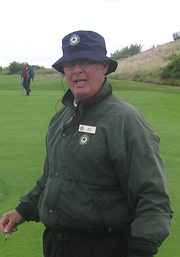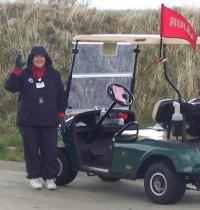There are probably as many reasons for volunteering as there are volunteers — and the Colorado golf community is no exception in that regard.
For Jan Fincher (pictured), it took a calling — literally — to get her into volunteering for the CWGA. As for Dave Wining, one of the things that keeps him motivated as a longtime CGA volunteer course rater is “the passion to try to get on every course in the state.”
Some people volunteer for the love of the sport, the desire to give something back, the quest to be a positive influence on kids’ lives, and to help fellow golfers better understand the game. There’s even a social aspect to it. The list goes on and on. But the bottom line is, if it weren’t for all the people giving freely with their time, organizations like the CGA, CWGA and CJGA would be a shell of what they are now.
“Volunteers are the lifeblood of amateur golf associations,” CWGA executive director Robin Jervey said. “In our case, with 18,500 (CWGA) members and 250 member clubs, a staff of six couldn’t get it done.”
Added CGA executive director Ed Mate: “We wouldn’t exist without volunteers. From governance on down, everything we do is driven by volunteers. It doesn”˜t work without staff, either. It”˜s a 50-50 deal, like with most non-profits.
Golf volunteerism is “sort of an inherent love affair with the game and the desire to give back; it all starts with that,” Mate said. “It’s like, “˜The game has given so much to me, now it’s my time to give back.’ There”˜s a large tradition of that.”
Between the CGA, CWGA and CJGA, a few hundred people volunteer their time any given year. Some, like CGA president Jim Magette and CWGA president Joanne Braucht, devote countless hours to the cause. “They’re up to their neck in work,” Mate said of the organizations’ presidents,
But volunteers fill a variety of roles, primarily involving the governing boards and their committees, tournament officiating and course rating. And some volunteers really rack up the hours by serving in two or three of those categories.
For their part, Fincher figures she volunteered about 50 days of work for the CWGA last year, while Wining said he typically does 35-50 days per year.
Fincher was “recruited” into the CWGA fold by a couple of her former phone company co-workers — and CWGA volunteers — Marge Gorshe and Barb Schutz. When Fincher was in the midst of competing in a CWGA event in Boulder, she recounts, “Marge yelled at me, “˜Is that Jan Fincher that worked at the phone company?'” From there, Gorshe and Schutz convinced her the CWGA was a great volunteer opportunity.
Nowadays, Fincher is the chair of the CWGA Rules Committee, so in addition to attending board and committee meetings, she serves as a rules official, conducts rules seminars at clubs and for high school players, attends a USGA workshop and spends a couple of days working at the Denver Golf Expo.
“When I retired, I took a year off, but I had to decide what to do as a retiree,” Fincher said. “I decided on golf and dogs.” The dog part involves organizing therapy dog work at various hospitals in the Boulder area. As for golf, her forte is sharing with others her knowledge about the Rules of Golf.
“I like to help people understand the nature of the game, not just going out there and hitting it,” Fincher said. “There are always ways to make things work better, and I try to help make that happen.”
As for Wining, he got the itch to volunteer with the CGA when a CGA course rater once joined Wining’s group for a round of golf. When Wining heard about what a course rater did, he thought it might be ideal for him after he retired from IBM/Lexmark. After gradually learning the intricacies of the job, Wining built up to where he’s helped rate as many as 30-35 courses per year for the CGA. He also serves as a board member, a rules official, and is responsible for some computer work regarding course rating.
Although Wining admits, “I fell in love with doing ratings,” he also enjoys being a rules official, particularly in junior tournaments where he can be proactive in preventing rules violations and helping kids learn the dos and don’ts. “I’d rather do that than just be a forecaddie for the big guys when they hit it crooked,” he said.
In the course ratings arena, Wining said, “I have a goal to be on every course in the state (he’s hit all but about 40 so far). Every time one comes up (for certification or recertification), I’m coming along. If they can use the help, great, but I want to come along regardless. (Course rating) is a great way to see courses I don”˜t typically get on and to help a little.”
CGA course raters typically do their rating work in the morning, then play the course in the afternoon.
“I love the work. It’s great to work with the staff they have there (at the CGA),” Wining said. “And it’s a good way to fill out the spring and summer.”
 Wining is one of the people who have volunteered the most time for the CGA and CJGA in recent years. Included among those who likewise fall into that category are Magette, CGA vice president Tom Lawrence, Bill Fowler, Rules Committee chairman Mike Boster (pictured at left), Frank Beckman, Dick Payne, Rich Langston and Mike Bureman. Not coincidentally, several of those volunteers have won the CGA Jim Topliff On-Course Official of the Year award — Bureman (2005 and 2010), Wining (2009), Beckman (2007) and Payne (1999 and 2001).
Wining is one of the people who have volunteered the most time for the CGA and CJGA in recent years. Included among those who likewise fall into that category are Magette, CGA vice president Tom Lawrence, Bill Fowler, Rules Committee chairman Mike Boster (pictured at left), Frank Beckman, Dick Payne, Rich Langston and Mike Bureman. Not coincidentally, several of those volunteers have won the CGA Jim Topliff On-Course Official of the Year award — Bureman (2005 and 2010), Wining (2009), Beckman (2007) and Payne (1999 and 2001).
Overall, 58 people worked a total of 530 tournament days for the CGA and/or the CJGA in 2010. Three individuals spent more than 30 days in that capacity last year — Beckman (37), Payne (33) and Bureman (31).
Dustin Jensen, director of youth programs for the CGA, estimates that 25 officials work junior tournaments in a given year. Among the longtime regulars are Langston and Boster.
“Some work a crazy number (of events),” Jensen said. “The organization would not exist without them, without people who have a passion for the game. They’re at the core of who we are. They truly care about the kids.”
On the junior level, in addition to the rules officials, many people volunteer on the junior development, junior tournament and caddie/Eisenhower-Evans committees.
Jervey said about 100 volunteers do work for the CWGA by serving on the board or committees, being a rules official for some of the 56 days of tournament golf the CWGA oversees, or rating the 30-35 courses the CWGA typically handles per year. Among those who have been longtime regulars are Braucht, who spends considerable travel time going to and from her home in Cotopaxi (a one-way trip of 150 miles), Fincher, JoAnn Dunham, Schutz, Ouida Neil and Sharon Simpson. At the CWGA’s annual meeting next month, Sally Lou Schultz, a past president of the CWGA, will be named the 2010 winner of the CWGA Volunteer Award, given in her case for a lifetime of service to the organization. Winners of that award in recent years also include Schutz (2009), Joan Scholes (2008) and Neil (2007).
“The USGA has about 2,500 volunteers, and we’re a scaled-down version of that,” Jervey said. The CWGA volunteers “are a great group of women who all share a love of the game and have a desire to give back. They make everything work.”
So where do all these volunteers come from? Many, as in the cases of Fincher and Wining, are from word of mouth. Some just inquire from out of the blue. Others are inspired through a rules seminar or other public function the CGA, CWGA or CJGA conducts.
And, of course, there are different needs at different times. This year, for instance, with an expanding emphasis on junior development, the CGA and CJGA will be looking for more volunteers in that area. (Anyone interested can contact the CGA at 303-366-4653.)


